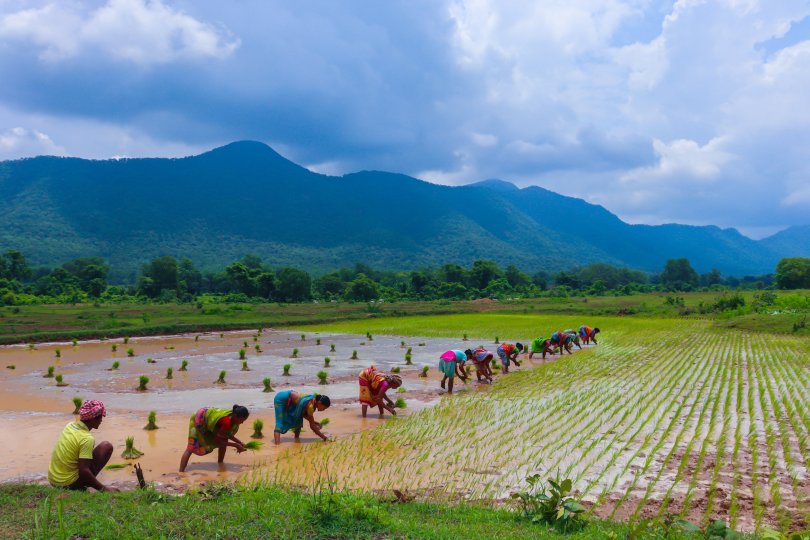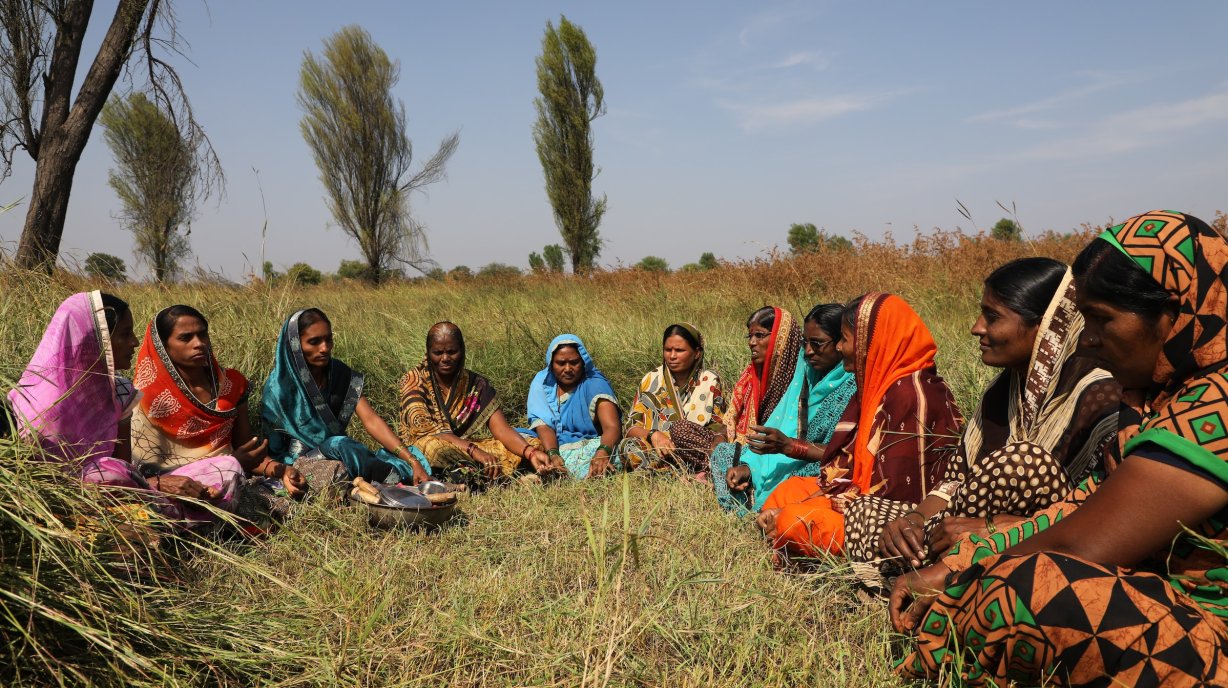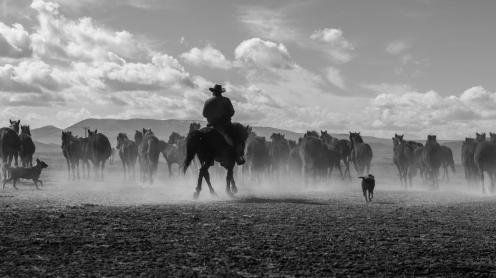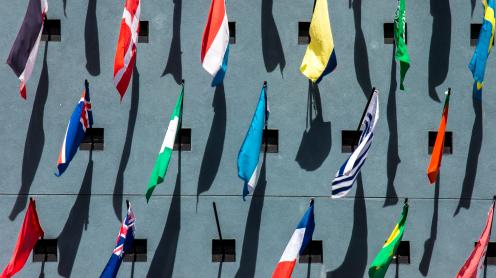In India, microcredit helps to cushion climatic shocks, finds economist Timothée Demont in his research on community-based economic Self-Help Groups in the eastern state of Jharkhand. His analysis focuses on the effects of these groups on the economic resilience of villages when droughts affect harvests.
In November 2020, thousands of Indian farmers gathered outside Delhi to protest against new laws liberalizing the agricultural sector. These measures have fanned the flames of anger among farmers, who were already denouncing inadequate incomes, massive over-indebtedness and corruption surrounding subsidies.
In India, the world's fifth-largest economy and fourth-largest agricultural producer, the sector employs half the population but accounts for only 16% of GDP. In this water-deficient country, the economic situation of Indian farmers is closely linked to climatic events. According to a World Bank report, 26 million people in India sink into poverty every year as a result of natural disasters1. In his study, economist Timothée Demont analyzes the effects of community microcredit groups in combating income variations linked to climate shocks.
- 1Hallegatte S, Vogt-Schilb A, Bangalore M, Rozenberg J, 2017, "Unbreakable: Building the Resilience of the Poor in the Face of Natural Disasters". Washington, DC : World Bank.
Income based on unpredictable weather
In the 1990s, in response to extreme poverty and fluctuating incomes, India's National Bank for Agriculture and Rural Development (NABARD) set up large-scale Self-Help Groups (SHGs) throughout the country. The principle is simple: a group of around 15 women is formed in each village. They contribute a certain amount of money each week, and use this common pot to grant loans to those who need them, setting an interest rate and repayment schedule in advance. These loans can be used to finance farm-related purchases (fertilizer, equipment rental, stock purchases), as well as health, education and consumer expenses.
Timothée Demont's research focuses on 36 villages, all located in the Jharkhand region, with a variety of climates and weather events. The villages were selected at random, using a method known as "randomization". Popularised by the Nobel Prize-winning economist Esther Duflo, this method enables the selection of statistically identical villages. Starting in 2002, the local NGO partner PRADAN set up microcredit groups in the randomly selected villages, with the other villages in the study acting as control villages. The researcher then studied the gap between the "treated" and "control" villages over a six-year period, to assess the effect of Self-Help Groups on the villages' economic resilience in the face of water scarcity.
Eastern India, the study region, is particularly vulnerable to weather conditions, since the majority of crops, mainly rice paddies, depend on rainfall. With no irrigation system in place, rice paddies need abundant monsoon rains during the summer months to ensure a sufficient harvest in the winter months, enabling them to generate enough income for the coming year, and the purchase of new seeds. However, the balance is fragile. In some years, days of drought follow on from one another, the monsoon arrives too late or brings insufficient rainfall. In 2019, the delayed monsoon caused the loss of 22% of the national rice production, with dramatic effects on the incomes of hundreds of millions of families.
Promising results
In years when there is a shortage of rain, the effects of the Self-Help Groups are manifold. Firstly, in the year following a bad rain, access to credit for households benefiting from the Self-Help Groups remains stable or even increases, unlike in the "control" villages. This is because traditional loans in rural India are granted by a wealthy person or landowner in the village. However, in the event of a climatic shock affecting the whole village, this lender will not be able to meet the credit needs of all affected inhabitants. With a Self-Help Group, on the other hand, contributions are spread over several years, during which the available funds grow with interest and contributions. This mechanism makes it possible to provide more loans in one year than in other places. Access to credit is thus stable and counter-cyclical, i.e. independent of the current year.
Furthermore, some Self-Help Groups formed several years ago have access to larger group loans from commercial banks. As the Self-Help Group's financial capacity develops over the years, the villagers' banking capacity is considerably strengthened, enabling them to access banks in areas where they are often absent. As a result, families who were unable to travel to a bank, which is sometimes a long way from the village - for lack of means, disability for example, or collateral - can now be represented by a member of the group.
The second effect analyzed is the influence of these groups on village food security. The researcher was particularly interested in the so-called "hunger gap" period, the period from July to September, just before the first harvests, when grain from the previous harvest is often exhausted, prices are at their highest and expenses for the new agricultural season have to be met, while the next harvest is still several months away (December-January) (see calendar). Village members had to answer questions such as "Have you had enough to eat in the last few days?" or "How many times a day have you eaten? Unsurprisingly, during the lean season, the villages covered by the microcredit groups experienced less food shock than the others. In those years, the "control" villages had, on average, less consumption income than those that had been "treated".
A positive migration
The third conclusion is more surprising: in villages where a Self-Help Group has been introduced, seasonal migration is higher than in other villages. Rational and organized, it plans in anticipation of a poor harvest. When a family notices insufficient rainfall during the summer, it plans for one of its members to leave for the winter, often the head of the family. His or her work in town or off the farm will enable a diversification of income to compensate for the poor harvest to come. But this seasonal exodus is costly and risky. Microcredit groups can help with the costs, such as transport or in the event of failure to find work. As a result, the overall economic situation of SHG villages becomes more stable. They also benefit from an informal mutual aid effect, thanks to group meetings that share information on where to find work, enabling new departures with less financial risk.
In India, for example, Self-Help Groups are proving highly beneficial in the event of climatic shocks, in terms of access to credit, food security and income smoothing supported by economic migration. In addition to the economic effects, it can also be argued that they affirm the role of women within the community. Thanks to their decision-making role in the borrowing process, their participation in the economic life of the village is strengthened. In view of these many positive effects, why not replicate this system internationally?
A model to replicate?
In Africa, the Rotating Savings and Credit Association (RSCA) system, or "tontine", has existed since the 17th century. It works on the basis of regular contributions, with all savings paid out to members in turn. However, this system cannot cope with a shock such as an unforeseen climatic event, as can the Self-Help Group's Accumulating Savings and Credit Association (ASCA) system, which has grown in size over the years.
Many microcredit initiatives, such as Self-Help Groups, have been inspired by the Bangladeshi model of the Grameen Bank. Set up during an episode of famine in 1976 with the savings of Muhammad Yunus, professor of economics at Chittagong University, it granted loans to the most precarious inhabitants without possession or guarantees, particularly women, in order to promote entrepreneurship. According to the World Bank, several million Bangladeshi women have been lifted out of chronic poverty thanks to these loans - a claim that is sometimes controversial. In 2006, the "Banker to the Poor" was awarded the Nobel Peace Prize for his micro-credit system, which has since been exported worldwide in a variety of forms.
In the wake of the Grameen Bank, many financial players have entered the microcredit market, opening the door to numerous abuses. In addition to sometimes exorbitant interest rates and aggressive collection methods, some commercial loans are granted not with a view to financial empowerment or business investment, but for the consumption and running costs of households in precarious situations. These loans have led to inevitable payment defaults, plunging beneficiaries into a spiral of excessive debt2. A far cry from the original aim of eradicating poverty.
- 2Human Rights Council, United Nations, 2020. Report of the Independent Expert on the effects of foreign debt and other related international financial obligations of States on the full enjoyment of human rights, particularly economic, social and cultural rights

Picture by Jagamohan Senpati on Unsplash
Microcredit can't do it all
By counteracting a climate of skepticism surrounding microcredit and analyzing its relatively undocumented effects, this research on Self-Help Groups can give new grounds for optimism concerning small-community solidarity systems, based on social guarantees and a strong human dimension. In the case of the Jharkhand region, although payment terms are longer because the group makes them flexible, the recovery rate is close to 100%, according to the researcher. You don't want to default or put your neighbour or family member into debt.
While the Self Help Group system, by smoothing out income over the course of a year, could be one of the solutions to be mobilized in the face of the droughts that are tending to intensify, it will not be able to do everything. India is considered one of the most vulnerable countries to climate change and natural disasters. Regularly hit by dramatic monsoons, rainfall deficits and cyclones, it is increasingly affected by extreme heat events. During the monsoon season of 2022, certain regions of India experienced temperatures approaching 50 degrees Celsius, which can be lethal outdoors. According to the CNRS, these heat episodes will be twice as frequent by 2060, making certain regions of India uninhabitable.














